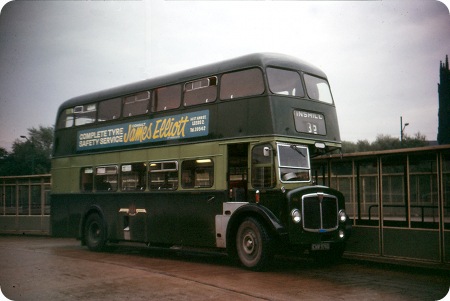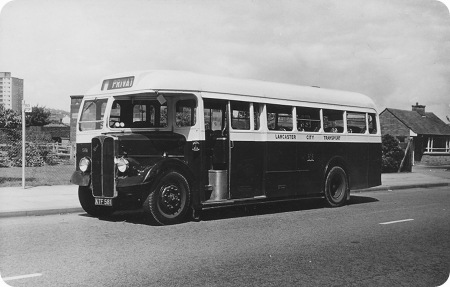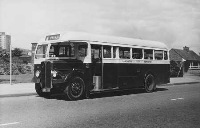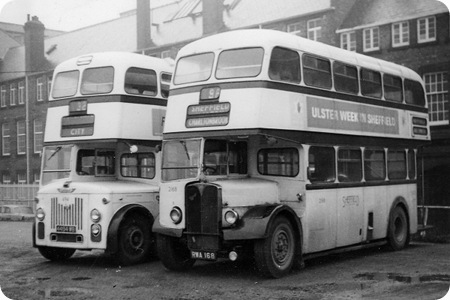Leeds City Transport – AEC Regent V – ENW 980D – 980
Leeds City Transport
1966
AEC Regent V
Roe H39/31R
Perhaps this snippet about Leeds City Transports AEC Regent V fleet number 980 which has been preserved and is stored at the Keighley Bus Museum may be of interest. 980 spent most, if not all of its service life at the Headingley depot along with the remainder of the batch 974 – 983. I don’t know the technicalities but it was fitted with some kind of modified exhaust system which gave a totally different tone to the norm, especially when pulling hard. As it passed its home depot on the routes northwards out of Leeds it was instantly recognisable by the unique sound alone. The tone was uncannily like that made by a water craft when the exhaust dips below the surface and accordingly amongst enthusiast staff 980 enjoyed the nickname "The motor boat". Very happy days indeed.
Copy contributed by Chris Youhill
———
The exhaust sounds like an example of the famous AEC "straight through" exhaust – common on Regent IIIs, less common but not unknown on Regent Vs.
My passions are AECs and bodywork by Burlingham, Roe and Weymann. What an fine photograph of a beautiful bus. I am actually very concerned about the future of a similar bus ex Sheffield B fleet number 1330 registration number 6330 WJ which has been in the limbo of being half restored at Sheffield, South Yorkshire. An almost identical 2D3RA of 1960 vintage.
David Oldfield
———
I know the Mark IIIs wonderful barking "straight through" sound that you mean – this magnificent recital was fitted to most if not all of the Leeds City Transport "PUA" registration batch, of which 674 was undoubtedly the finest as it bellowed its way through the City Centre usually on services 42/66 from Harehills to Old Farnley/Leysholme Estate.
However the "motor boat" sound produced uniquely by 980 was quite different and was somewhat muffled and refined, perhaps best described as gentle "under water" bubbling. What priceless memories we are lucky to enjoy.
Chris Youhill
———
Work is well underway on the above vehicle…this site will be kept informed of developments in due course.
Mick Holian
———
Leeds City Transport always seemed to have a well turned out fleet of interesting vehicles, but seeing and hearing one of their many Regent Vs was to many of us the icing on the cake. Whether it was a handsome Roe-bodied example, or one of the plainer (but slightly more imposing?) MCW ones with exposed radiators, it didn’t matter. To the ear they were just the same – gorgeous! Perhaps best summed up as the mechanical sound effects of a Routemaster, coupled to the exhaust system of a decent sports car?! They were once a common sound booming their way up The Headrow past Lewis’s. If you were lucky enough, sometimes a skilled driver with a tuned ear would ‘hold’ a bus on its exhaust bark for quite a distance up the gentle incline. Bliss!….and a damned sight better than todays droning Volvo B7TLs!
Brendan Smith
———
Mention of the PUA registered 1952 AEC Regent IIIs brings to mind the Roe advert which adorned Leeds timetables for many years 669 was used until the nineteen sixties when it was replaced by a dual doored AEC Reliance in 1967 this was replaced by 131 the first of Leeds 33 foot Fleetlines the last Leeds bus to appear was a 1968 Daimler Fleetline with Roe dual door body. A small batch of these AECs carried very shapely Weymann bodywork.
Chris Hough
———
The six handsome Weymann "PUAs" were numbered 649 – 655 and they were a pleasure to behold from outside, and when on board you could enjoy some of the last Leeds buses to have the "warm" light beige window surrounds – I always thought that the subsequent silver ones were harsh and a retrograde step.
Chris Youhill
———
I have quite a collection of LCT photos click here to view. Some of them should bring back an odd memory or two!
David Beilby
———
25/09/11 – 07:18
Some of these AEC’s had a short spell with Tyne and Wear PTE (formerly Newcastle Transport) I believe they had been let down with a delivery of new vehicles and the AEC’s were brought in as a stop gap. They were used on the 18/19 Walker Circle route and were still in their LCT livery, but the panel around the radiator grill had been painted yellow.
Ronnie Hoye
———
25/09/11 – 09:00
I think that the L.C.T. buses that went to Tyne and Wear initially went to OK Motor Services but were not used by them. Tyne and Wear also painted the first panel on either side in their yellow livery.
Philip Carlton
———
25/09/11 – 09:03
They did look interesting in Newcastle didn’t they ?? The one in this picture though, 980, travelled even further north and served with A1 Services of Ardrossan in another fine green livery before being "repatriated" and is now approaching restoration to perfection standards at Keighley Bus Museum.
Chris Youhill
———
25/09/11 – 15:20
Further to my comments about LCT Buses in Newcastle, ironically, not long before the arrival of the LCT buses, Newcastle had decommissioned their own Park Royal bodied Mk V AEC’s, some were low bridge variants for the No 5 Ponteland/Darras Hall route, I also seem to remember some other foreigners from Edinburgh and Leicester were in Newcastle at the same time.
Ronnie Hoye
———
26/09/11 – 15:06
The PTE in Newcastle suffered a severe vehicle shortage and purchased a small number of ex Leeds AEC Regents and at least one Roe bodied PD3/5 all had PTE Yellow applied to their bonnets In addition the PTE loaned buses from Plymouth (MCW bodied Atlanteans) Lothian (Alexander bodied PD2s) Bournemouth (Atlanteans with Newcastle style MCW bodywork) Leicester (PD3s with East Lancs bodywork0 and Southend (Fleetlines with NCME bodywork)
Chris Hough
———
29/01/12 – 17:48
Yep about half a dozen Regent V"s and the PD3/5 along with all the other exotic birds were allocated to Byker depot and we had a trip out to photograph them. To add to the interest the restored Newcastle Leyland PD2 (in blue livery) and some ex Standerwick Bristol VRLL"s for the ferry services were also on shed. Newcastle was a very interesting place at that time. I am told that the Regents subsequently went to the magnificent OK motor services but not sure if they were ever used (possibly cannibalised for parts?)
Tony Greig
Quick links to the - Comments Page - Contact Page - Home Page




